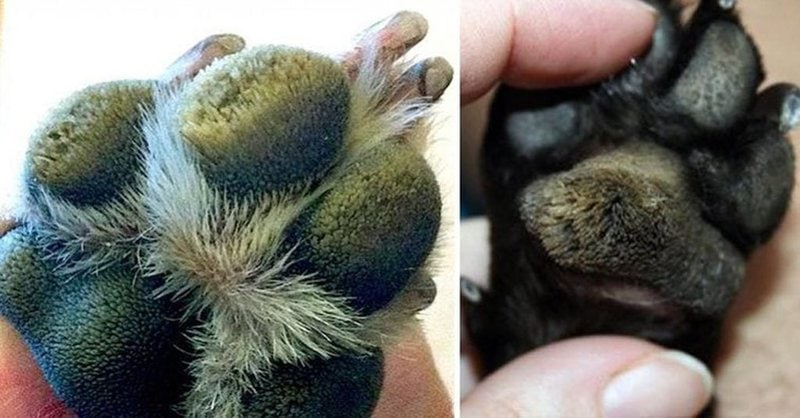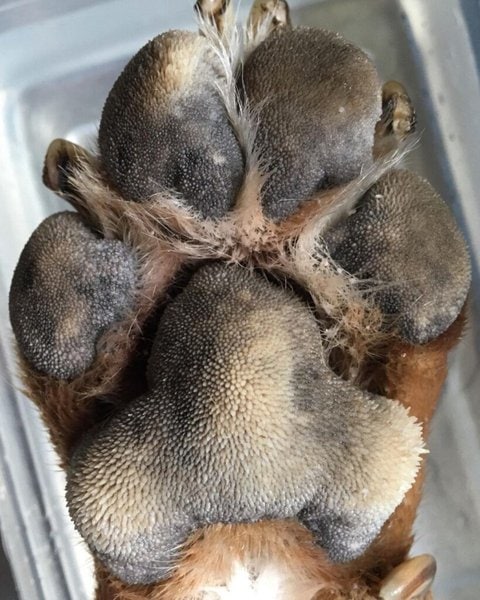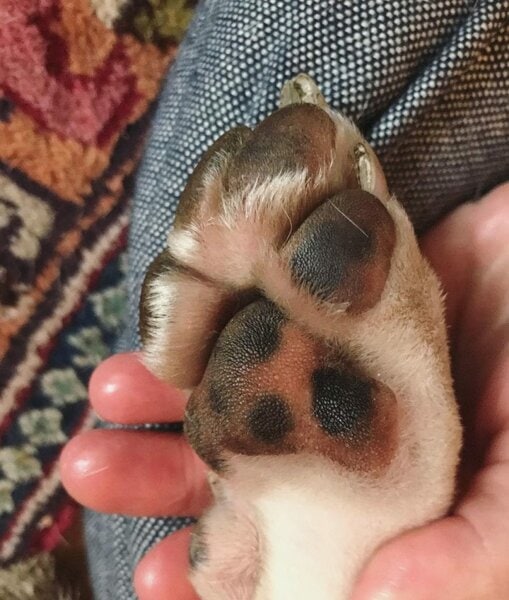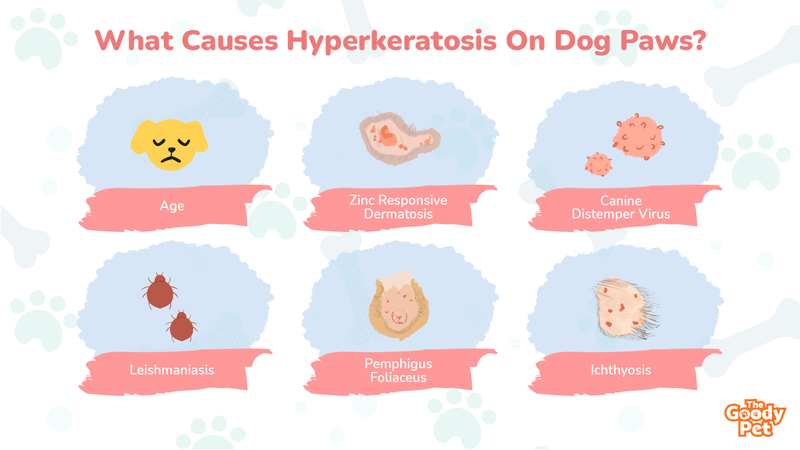Do you notice your mature dog’s paw roughly scratching your skin or getting tangled in the fibers of your clothes when it tries to reach for you? This may be a sign that it is suffering from a condition known as dog paw hyperkeratosis.
Dog paw hyperkeratosis is sometimes referred to as “hairy paws” disease because of the hair-like appearance in their paw pads. Your dog’s paw looks hairy because there is an excessive amount of keratin responsible for the formation of tissues of the hair, skin, and nails.
If there is too much production of this protein in the paw’s outer layers, it causes it to thicken, harden, and lose moisture leading to cracks and fissures that appear hair-like. It can cause some discomfort and pain and, in some instances, secondary infection if not treated properly.
In this article, we will learn about the causes, treatment, and prevention of this disease and the proper management and care that you can do if your pet happens to acquire this dermatological condition.
What Causes Hyperkeratosis On Dog Paws?
Genetics is the main cause for hyperkeratosis and symptoms usually appear as early as one year old when the dog is predisposed to this disease.
The breeds most susceptible are Labrador Retrievers, Golden Retrievers, Dogues de Bordeaux, Irish Terriers, Bedlington Terriers, Boxers, French Bulldogs and English Bulldogs.
The other medical reasons why your dog has hyperkeratosis include:
Age
Middle-aged and senior dogs could develop this condition, but it is considered not to be severe. It is normal for the body to produce more keratin in the paws when it is subjected to pressure or when there is inflammation, just like we develop calluses in our hands and feet.
Mature dogs who develop this disease are potentially symptomatic of chronic liver disease or a tumor in the pancreas. Do bring your pooch down to the vet for a checkup.
Zinc Responsive Dermatosis
A rare condition is when dogs have problems absorbing zinc in their lower intestines or when they are given supplements that block zinc absorption.
Zinc is important for many metabolic functions and assists hormone production in the thymus gland and proper functioning of proteins. It is essential for healthy skin and for brain functions.
Lacking in this mineral causes stunted growth, diarrhea, and cracked and crusted footpads or hyperkeratosis.

Canine Distemper Virus
Dogs infected with canine distemper virus (CDV) can develop hard pad disease which is marked by footpad epidermal proliferation and hyperkeratosis. Prevention is the key, so have your dog vaccinated against CDV.
Leishmaniasis
This is a disease caused by a parasite called Leishmania that spreads through the bites of phlebotomine sandflies. This is common in tropical and sub-tropical areas and the parasite causes skin lesions resulting in the rampant production of keratin. The parasite is found to be endemic in Texas, Oklahoma, and Florida.
Pemphigus Foliaceus
This is an autoimmune skin disease characterized by the loss of adhesion between keratinocytes within the epidermis resulting in an encrustation of the footpads and hyperkeratosis.
Ichthyosis
This is a rare skin disease caused by a recessive genetic mutation. The outer layer of the skin or epidermis does not develop properly resulting in rough, greasy flakes adhering to the hair and it affects their noses, muzzles, and paw pads.
Some might notice that there is an unpleasant smell in their dog’s paws that could be caused by a fungal infection. This would not cause hyperkeratosis, but it gives the paw pads a different texture.
Is Hyperkeratosis In Dogs Serious?
Dog paw hyperkeratosis can be a serious condition if left untreated and not managed properly. It can inflict pain during movement with every step your dog takes, leading to health complications due to lower activity levels.
In this section, we’d give you more information such as the signs and symptoms, if hyperkeratosis causes pain, and if it is a contagious condition. Plus, we’d share with you helpful tips on how to prevent your dog from getting hyperkeratosis.
Signs And Symptoms
Aside from physically checking your pet for any signs of dryness in their paws, a lot of the signs that your pet has this condition could be observed through changes in their behavior.
Young dogs who have the disease may not show any discomfort at first, but as they mature, may develop some sensitivity. Here are some early signs to look out for if you suspect that your pooch is having this disease:
- The dry and rough texture of the paw pads
- Unusual crusty layer and deep grooved cracks
- Bleeding
- Calloused paws
- Frequent licking of their paws
- Lack of motivation to play or walk
- Limping while walking and inability to walk in a straight line
- Sensitivity and pain in their paws

Is Dog Paw Hyperkeratosis Painful To Dogs?
Hyperkeratosis can cause some discomfort for your dogs to stand and walk because it is painful. This would result in reduced activities and eventually have an effect on their overall health. Visit your veterinarian if you suspect hyperkeratosis since this is also a symptom of other illnesses.
Fortunately, hyperkeratosis is not contagious. It is mostly caused by genetics or by old age, parasites, or viruses.
Preventive Measures
This disease is incurable, and the best defense is taking some preventive measures.
- If your pet is predisposed to some genetic diseases, a regular checkup with your veterinarian is the best recommendation since they could easily pinpoint the early signs of hyperkeratosis and how best to manage it.
- Keeping your area clean, especially your yard for any possible insect infestation that might be carriers of disease-borne parasites like leishmania.
- Keeping a balanced and healthy diet with the right amount of vitamins and minerals would prevent zinc deficiency that could cause hyperkeratosis.
- If your dog already has dog paw hyperkeratosis, it is recommended to shorten his daily walks and take breaks more often. Buying him a stroller is also one great option.
How Do You Treat Hyperkeratosis In Dogs Paws?
While hyperkeratosis can be painful for your dogs, proper management is key to deal with it well. This is a condition that cannot be cured but it does not mean that your dogs cannot live long and normal lives.
Taking your pet to the veterinarian is the first step in managing dog paw hyperkeratosis. It is important to first learn the underlying causes of the disease before learning how to handle its treatment.
Blood work can be done to know if parasites, infectious diseases, or autoimmune diseases are the culprit. The veterinarian will also check if there are secondary infections that may worsen the condition of your dog.
The possible treatments for dog paw hyperkeratosis include:
Removal Of Excess Skin
The veterinarian may recommend removing excess skin from the dog’s paw by trimming it with scissors or nail clippers just like you would cut a hair. This is recommended to be done by professionals since you might inadvertently injure your dog, especially for dogs who do not want their paws to be touched and don’t hold still.
However, if your veterinarian has trained you properly, then it can be done. Removing the crusty part every few months will get rid of hyperkeratosis to make your dog walk comfortably.
Apply An Ointment
A soothing paw balm to help moisturize the pads is helpful in treating hairy paws and helps prevent too much cracking. Bodhi Dog USDA Certified Organic Paw Balm relieves dried-out, cracked, and crusty paw pads so that your dog will be able to walk a lot easier.
It is made with organic ingredients, such as shea butter, jojoba oil, beeswax, and hemp seed oil with no harsh chemicals. It softens the paw pads and prevents bleeding when it gets too dry.
Paw Soak
The dry dog paws could be soaked in warm water with some Epsom salt for 15 minutes. Make sure to dry it completely afterward to prevent infection from excess moisture.
Doggie Sauna
Turn on your shower to create some steam in the bathroom. The moisture will relieve and soften the dry and cracked paw pads. Again, dry their feet completely to prevent infection.
Use Boots Or Socks
It would be easier for your dogs suffering from hyperkeratosis to take their necessary walks by providing them with booties or socks. Hard and rough surfaces are painful to walk on especially when it is hot or cold outside. Socks with rubber grips are recommended to prevent slipping.
Treating The Underlying Cause
Your veterinarian might prescribe immunosuppressive drugs if your pet is suffering from pemphigus foliaceus or some zinc supplements if he is deficient in that mineral.
For dogs suffering from leishmaniasis, an injection of miltefosine with allopurinol for a period of 6 to 12 months is administered to prevent relapses of the infection.






